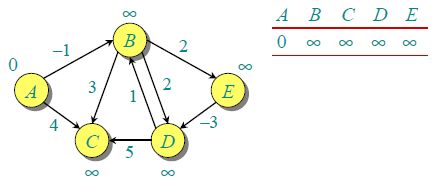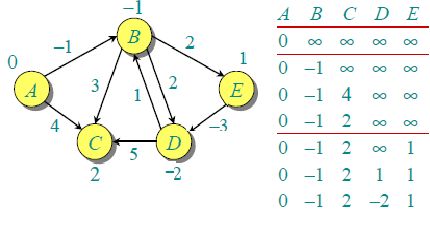Bellman-Ford算法---求包含负权边单源最短路径(动态规划)
单源最短路径:给定一个图,和一个源顶点src,找到从src到其它所有所有顶点的最短路径,图中可能含有负权值的边。
Dijksra的算法是一个贪婪算法,时间复杂度是O(VLogV)(使用最小堆)。但是迪杰斯特拉算法在有负权值边的图中不适用,
Bellman-Ford适合这样的图。在网络路由中,该算法会被用作距离向量路由算法。
Bellman-Ford也比迪杰斯特拉算法更简单和同时也适用于分布式系统。但Bellman-Ford的时间复杂度是O(VE),E为边的个数,这要比迪杰斯特拉算法慢。
算法描述:
输入:图 和 源顶点src
输出:从src到所有顶点的最短距离。如果有负权回路(不是负权值的边),则不计算该最短距离,没有意义,因为可以穿越负权回路任意次,则最终为负无穷。
算法步骤:
1.初始化:将源节点到其他所有顶点的距离初始化为无穷,到自身距离初始化为0.
存放在构造的大小为|V|的dist[]数组中。 d[v] ← +∞, d[s] ←0;
2.计算最短距离。迭代求解:反复对边集E中的每条边进行松弛操作,使得顶点集V中的每个顶点
v的最短距离估计值逐步逼近其最短距离;(运行|v|-1次)
做法如下:
Do following |V|-1 times where |V| is the number of vertices in given graph. …..a) Do following for each edge u-v ………………If dist[v] > dist[u] + weight of edge uv, then update dist[v] ………………….dist[v] = dist[u] + weight of edge uv 3.检验负权回路:判断边集E中的每一条边的两个端点是否收敛。如果存在未收敛的顶点,则算 法返回false,表明问题无解;否则算法返回true,并且从源点可达的顶点v的最短距离保存在 d[v]中。 做法如下: Do following for each edge u-v ……If dist[v] > dist[u] + weight of edge uv, then “Graph contains negative weight cycle” The idea of step 3 is, step 2 guarantees shortest distances if graph doesn’t contain negative weight cycle. If we iterate through all edges one more time and get a shorter path for any vertex, then there is a negative weight cycle关于该算法的证明也比较简单,采用反证法,具体参考:http://courses.csail.mit.edu/6.006/spring11/lectures/lec15.pdf
该算法是利用动态规划的思想,以自底向上的方式计算最短路径。
它首先计算最多一条边时的最短路径(对于所有顶点)。然后,计算最多两条边时的最短路径。外层循环需要执行|V|-1次。
算法实例:
给定源顶点为0,将源顶点与其他顶点距离初始化为无穷,与自身距离为0。
因为有5个顶点,因此所有的边需要处理4次。

按照以下的顺序处理所有的边:(B,E), (D,B), (B,D), (A,B), (A,C), (D,C), (B,C), (E,D).
第一次迭代得到如下的结果(第一行为初始化情况,最后一行为最终结果):
当 (B,E), (D,B), (B,D) 和 (A,B) 处理完后,得到的是第二行的结果。
当 (A,C) 处理完后,得到的是第三行的结果。
当 (D,C), (B,C) 和 (E,D) 处理完后,得到第四行的结果。

第一次迭代保证给所有最短路径最多只有1条边。当所有的边被第二次处理后,得到如下的结果(最后一行为最终结果):

第二次迭代保证给所有最短路径最多只有2条边。我们还需要2次迭代(即所谓的松弛操作),就可以得到最终结果。
算法实现:
#include <iostream>
#include <limits.h>
#include <stdlib.h>
using namespace std;
//表示一条边
struct Edge
{
int src, dest, weight;
};
//带权值的有向图
struct Graph
{
// V 顶点的数量, E 边的数量
int V,E;
// 用边的集合 表示一个图
struct Edge* edge;
};
// 创建图
struct Graph* createGraph(int V, int E)
{
struct Graph* graph=(struct Graph*) malloc(sizeof(struct Graph));
graph->V=V;
graph->E=E;
graph->edge=(struct Edge*) malloc(graph->E*sizeof(struct Edge));
return graph;
};
// 获得单源最短路径,同时检测 负权回路
void BellmanFord(struct Graph* graph, int src)
{
int V=graph->V;
int E=graph->E;
int dist[V];
// 第一步初始化
for(int i=0;i<V;i++)
{
dist[i]=INT_MAX;
}
dist[src]=0;//src始终对应0!!!!
// 第二步:松弛操作.松弛所有的边|V|-1次
for(int i=1;i<=V-1;i++)
{//松弛次数
for(int j=0;j<E;j++)
{//每一条边
int u=graph->edge[j].src;
int v=graph->edge[j].dest;
int weight = graph->edge[j].weight;
if(dist[u]!=INT_MAX&&dist[u]+weight<dist[v])
{
dist[v]=dist[u]+weight;
}
}
}
//第三步:检查负权回路。上面的操作保证没有负权回路的存在
// 如果找到了更短的路径,则说明存在负权回路
for (int i = 0; i < E; i++)
{//遍历每一条边
int u = graph->edge[i].src;
int v = graph->edge[i].dest;
int weight = graph->edge[i].weight;
if (dist[u] + weight < dist[v])
{
cout<<"Graph contains negative weight cycle"<<endl;
}
}
//打印
cout<<"Vertex Distance from Source"<<endl;
for(int i=0;i<V;i++)
{
cout<< i <<"\t\t"<< dist[i] <<endl;
}
}
int main()
{
/* 创建 例子中的那个带权有向图的结构 */
int V = 5;
int E = 8;
struct Graph* graph = createGraph(V, E);
// add edge 0-1 (or A-B in above figure)
graph->edge[0].src = 0;
graph->edge[0].dest = 1;
graph->edge[0].weight = -1;
// add edge 0-2 (or A-C in above figure)
graph->edge[1].src = 0;
graph->edge[1].dest = 2;
graph->edge[1].weight = 4;
// add edge 1-2 (or B-C in above figure)
graph->edge[2].src = 1;
graph->edge[2].dest = 2;
graph->edge[2].weight = 3;
// add edge 1-3 (or B-D in above figure)
graph->edge[3].src = 1;
graph->edge[3].dest = 3;
graph->edge[3].weight = 2;
// add edge 1-4 (or A-E in above figure)
graph->edge[4].src = 1;
graph->edge[4].dest = 4;
graph->edge[4].weight = 2;
// add edge 3-2 (or D-C in above figure)
graph->edge[5].src = 3;
graph->edge[5].dest = 2;
graph->edge[5].weight = 5;
// add edge 3-1 (or D-B in above figure)
graph->edge[6].src = 3;
graph->edge[6].dest = 1;
graph->edge[6].weight = 1;
// add edge 4-3 (or E-D in above figure)
graph->edge[7].src = 4;
graph->edge[7].dest = 3;
graph->edge[7].weight = -3;
BellmanFord(graph, 0);
return 0;
}
执行结果:
Vertex Distance from Source
0 0
1 -1
2 2
3 -2
4 1参考:http://www.geeksforgeeks.org/dynamic-programming-set-23-bellman-ford-algorithm/